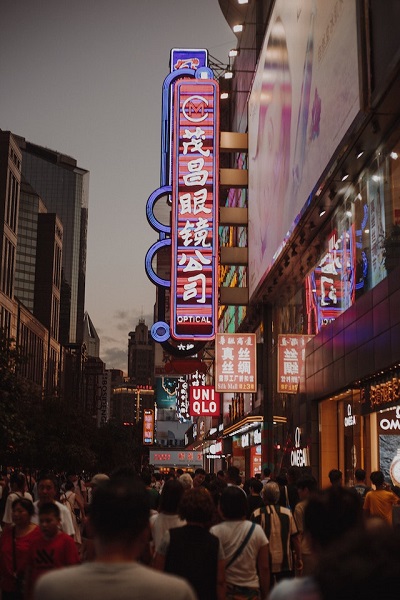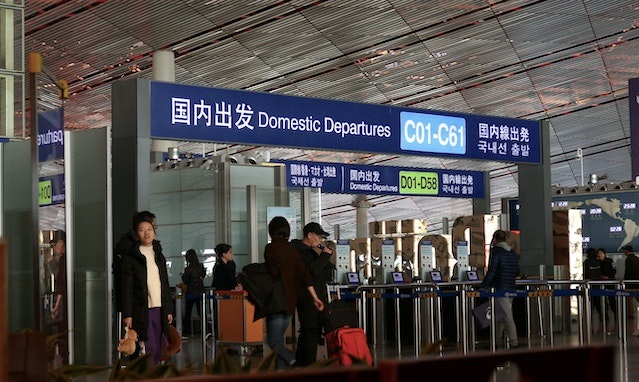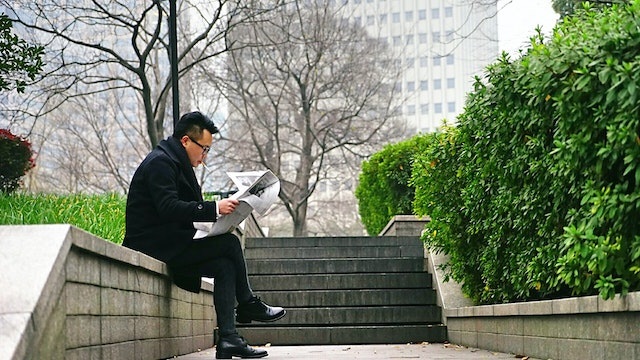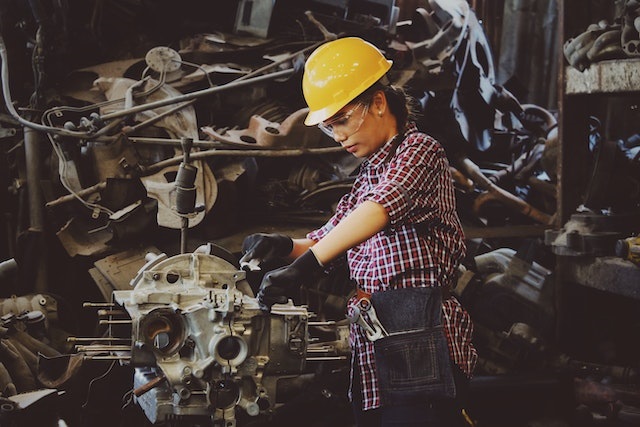Benefits of CCTV: Use of video surveillance in China
According to the 2021 report by the security researcher Comparitech, 54 percent of the world’s video surveillance cameras – that is 540 million pieces – are installed in China, which means nearly 373 cameras per 1,000 people.
In its report, the Indiatimes online magazine ranks the city of Shenzhen in China with its 520 cameras per square mile 4th of the top 20 most surveilled cities in the world. However, the list has 10 more Chinese cities, from Qingdao to Changchun, out of total 20 while other countries usually only have 1 city – their capital – in the list. Besides, although the UK’s capital, London, tops the list, China’s Taiyuan and Wuxi have more cameras per capita, according to Comparitech.
So what is the success story behind the rapid growth of CCTV systems in China and its global dominance? Although factors fueling the growth of technology usually are similar across various countries, China is somewhat different because of its unique political regime and technological might. Western media nicknamed China a Surveillance State, and it is generally pictured as the Orwellian dystopian society with a country-wide grip of control over citizens. Let us look deeper into why video surveillance is so prosperous in China.
 First off, the People’s Republic of China (often referred to as the PRC or simply China) is the undeniable global production leader, which includes manufacture and supply of technological equipment and hardware. Lower production prices resulting from the state political regime and industrious workers’ mindset inspired by the country’s ideology have facilitated China to win over competition among other countries. Everyone knows that: if it is the lower price that you are after, you bet you can get it in a Chinese product. Nevertheless, winning the competition is a process since to continue dominating the industry and stay competitive, a producer must always stay on top of the demand, evolving the products to adapt to the modern-day needs. The country being the force for progress makes it super easy for the state to get access to all the advances of technology at reasonable prices, especially since many largest corporations in China are completely or partly state-owned. Local production of what the state will be using, without the costs of import, boosts the economy, creates jobs for citizens, and serves as a staging area for testing of the systems for commercial sales too. So, to conclude, the availability of top-notch video surveillance solutions – both from financial and technical standpoint – is one part of their popularity in China.
First off, the People’s Republic of China (often referred to as the PRC or simply China) is the undeniable global production leader, which includes manufacture and supply of technological equipment and hardware. Lower production prices resulting from the state political regime and industrious workers’ mindset inspired by the country’s ideology have facilitated China to win over competition among other countries. Everyone knows that: if it is the lower price that you are after, you bet you can get it in a Chinese product. Nevertheless, winning the competition is a process since to continue dominating the industry and stay competitive, a producer must always stay on top of the demand, evolving the products to adapt to the modern-day needs. The country being the force for progress makes it super easy for the state to get access to all the advances of technology at reasonable prices, especially since many largest corporations in China are completely or partly state-owned. Local production of what the state will be using, without the costs of import, boosts the economy, creates jobs for citizens, and serves as a staging area for testing of the systems for commercial sales too. So, to conclude, the availability of top-notch video surveillance solutions – both from financial and technical standpoint – is one part of their popularity in China.
However, availability is nothing without the demand, and China has plenty of it when it comes to video surveillance. It has been reported by China officials that their goal is to have a digital surveillance apparatus with data about 100% of its population. With over 1.4 billion citizens and the 9,597,000 square kilometers territory, it’s an unimaginably difficult task that calls for any help possible, from innovations in video surveillance equipment to smart analysis techniques – anything that can be shifted some of the work load to. And so there came the solution: the real-time face recognition video analysis, a technology that in some countries only begins to be emerge, is blanketing the country of China and is said to have 1.4-2.5 bln face photos at any given moment. In just a few years after its introduction, use of this software technology quite rapidly has gained momentum and become widespread.
Of course, these two prime factors are complemented with the availability and effectiveness of video surveillance for personal and business uses too – although even combined these two realms cannot compete with the share of government in popularization of video surveillance in the People’s Republic of China.
So what exactly makes it so attractive to government, corporations and individuals? We will try to untangle what tasks can video surveillance help with in China below.
Homeland security and law enforcement

Video surveillance was invented as a natural response to communal crimes and violence acts. Nowadays, various ‘Safe city’ programs around the world are known to be state efforts aimed at social stability maintenance. Chinese policing system, too, boasts that facial-recognition systems regularly catch crooks. That can be true: even the perception of video surveillance presence can prevent crime and deter social unrest – just like it does make shoplifters seek an easier target without video surveillance rather than steal under the cameras and risk leaving a trail of evidence behind.
As any country, China has some internal issues. For example, due to former child birth policy, there had been a boost of kidnapping in the country at some time. Fortified by video surveillance and artificial intelligence, police gets vast powers to track criminals or drug smugglers, and aid criminal investigations, for example, to find abducted children, or to improve traffic management.
Enforcing traffic rules and promoting safe driving habits is a life-saving duty. Luckily, with video surveillance systems, many tasks can be automated. For example, patrol cars of the police officials can be equipped with smart dash cams that single out license plates of missing cars from the everyday vehicle traffic flow. City cameras hanging on every pole can be on the automated lookout for illegal parking, traffic rules violations like overspeeding, lane crossing, etc. – and work in combination with fining systems in the fully standalone mode. Let alone that recordings can be used for forensic purposes or a city-wide search. The state-of-the-art video surveillance software like Xeoma has these and many other traffic control tools.
Besides, mass surveillance has often been cited as necessary to fight terrorism (preferably – to deter it), especially in societies with historical ethnicity conflicts. Apart from the regular security monitoring of strategic areas, proactive video analytics can detect if a suspicious object has been left unattended in public spaces, especially those of mass gathering like airports or public transportation stations. Another example is artificial intelligence techniques which, when trained to detect weapons, can spot a person carrying a gun early on – and report it to the nearest police squad.
There’s also the duty of border security where smart cameras with video analytics on board can be a great aid in improving the level of security. The range of video analytics expertise is vast: from scanning the travellers faces for signs of aggression or nervousness, catching glimpse of weaponry or restricted import/export products, to automated access control systems with vehicle license plate recognition and scheduled patrols of land or sea borders with FPV drones.
Maintaining internal law and order is an important duty of any state that wants to make the country a secure and safe place for its citizens to operate in, so China dedicates much resources to that sphere of life.
Behavioral engineering

Prevention of crimes is proven to be more effective and beneficial in the long run than post-incident investigation. And probably the most effective strategy of deterring crime is the so called Behavioral engineering – combination of psychological and technological tactics to form a pattern for acceptable behavior among people, thus rooting out whatever is perceived as “uncivilized behavior”.
Video surveillance systems installed at crosswalks in China have been used for detection of jaywalking (crossing the street in prohibited places) – a minor offence, as some might think, but with disastrous consequences in places with high traffic. There are incidents where cameras helped fight the habit of public spitting, wearing pajamas on the street (a traditional fashion that the authorities attempt to fight), or even wasting toilet paper. China’s CCTV systems even facilitate fighting the “Beijing bikini” practice when men bare their bellies by rolling up their shirts in the summer. Isn’t it showing the great potential of detecting not just types of objects but also various types of unusual behavior? But it wouldn’t be that effective if not for the Chinese nationwide network of cameras being synchronized with a biometric database powered by facial recognition, which, in combination, does identification of people caught on camera, so the offenders can be found even if they manage to flee scene of the crime, and get a warning or a fine depending on the severity of their offence.
Speaking of behavior, contemporary video surveillance solutions like Xeoma which was not developed in China but can make a decent competition to Chinese know-hows with its innovative features, offers behavior analysis that can recognize if a person is in camera sight acting weird, has angry mood, etc.
All in all, experts say that harnessing vast inputs of behavioral data can affect behavior of the population to shape it in a way to create predictive policing and safe, stable societies.
Protection and regulation
Let’s not forget that there are more dimensions of public safety than prevention and investigation of criminal activity. For example, China has shown great results in handling the COVID-19 pandemic thanks to the disciplinary and technological measures erected. A raft of digital Covid-tracking tools has been put in place to facilitate control over social distance, stay time and quarantine recommendations. It was reported that law enforcement officials wore “smart helmets” with an AI-powered infrared camera embedded in the front to detect pedestrians’ temperature amid the COVID-19 pandemic. Video surveillance thermal cameras could be used to substitute workers that do temperature check at building entrances and are more than likely to catch and spread the disease, thus eliminating health hazards and restraining the epidemic. Another technological breakthrough was the “smart glasses” also equipped with facial and license plates recognition capabilities and the ability to scan QR codes. Live raw data from the cameras and various trackers was interconnected with the citywide databases of people who have a confirmed coronavirus case, are in quarantine, or suspected to have been in contact with a COVID patient.
The smart glasses and helmets with video surveillance cameras can also spot missing or wanted people in a crowd: criminal offenders or mentally ill people, people with the history of child abuse or drug use. Regular stationary cameras in public spaces now feature really smart video analytics that can make conclusions drawn from multiple suspicions. Examples include smart systems that can suspect possible case of prostitution if a woman checks into multiple hotels in one night, or catch unlicensed tour guides.
Advanced video analytical CCTV systems can even make out different animals be it pigs in a corral, pandas in a zoo, or falcons or horses in competitive animal sport to prevent frauds.
Besides the common intrusion detection (which can be set up to trigger at any motion events, in night-time, or upon detection of specific types of objects), modern video analytics can be deployed to fulfil tasks like recognize a fire hazard, identify people doing high-rise littering, stop graffiti artists or vandals, etc.
Indoor video surveillance
If outdoor video surveillance cameras have got the criminal activities that occur in streets and roads covered, there are also governmental and privately owned establishments that need protection of both assets and people. And truly, video surveillance handles indoor security as well as safety on the streets. See for yourself: medical facilities can have video analytics allowing to spot long queues that call for service optimization. Smart tools like slip and fall detector can detect if someone has fainted, etc. Facial recognition can be used for post-incident investigation, or for on-time notification about the appearance of a wanted criminal.
Schools and kindergartens can embark on the advances of artificial intelligence monitoring the premises for signs of weaponry or strangers. Besides, AI can be a tool to gather information on staff performance as well as enhance student engagement. Technologies like Face ID can be put to good use in the educational institutions for automation of entrance to campuses or buildings.
Industrial protection and operations improvement with CCTV

The industrial sector in China is abundant with various production units like plants and factories since the country is the world’s top exporter of equipment, clothing, footwear, furniture, plastic products, machine parts and tires, and accessorizes. To produce so many goods the country possesses over numerous refineries, warehouses, and similar facilities. CCTV systems powered by video analytics can not only do the regular job of ensuring proactive intrusion detection, criminal acts prevention and provision of video footage for forensic uses in such facilities. Thanks to latest developments, there are so many uses of video surveillance in China’s industrial sphere to improve production operations and outcomes, optimize processes, and automate routine tasks.
Proactive monitoring can be on the lookout for early signs of hazards like fire or smoke, ensuring compliance with safety and health regulations, control over productivity and filtering out faulty products reduce various types of losses. Besides, monitoring of the staff activities is known to have a reserving effect on workers thus creating a more productive atmosphere or at least cutting down losses caused by fraud, theft, or irresponsible behavior. For export-oriented manufacturing, especially in heavy machinery, remote acceptance features of video surveillance might be of great use, along with the regular trespassing detection in off-hours or 24/7 monitoring that CCTV provides.
Besides, license plate recognition and recognition of faces that work in combination with turnstile and gate barrier equipment can partly or completely replace a security guard with automated access control to the territory.
Businesses

Although the communist regime of the PRC used to rule out privately owned companies some time ago, this is no longer the case in contemporary China, and there is a place for non-governmental business too. With modern CCTV solutions, businesses of various scale and various domains – from hospitality and real estate to entertainment and food industry – can unlock unprecedented opportunities of how to increase security and safety levels, boost productivity and improve operational efficiency, as well as have the machines do routine work instead of human workers. CCTV systems with AI are a great aid in tackling away various challenges faced by businesses, whether in offices or retail outlets, productions or transportation units, HoReCa or entertainment establishments.
Businesses that are equipped with video surveillance systems face less burglaries or cashier frauds, while at the same time are endowed with vital statistics on the potential and existing clientele. Unique visitors calculator relies on the already mentioned Face Recognition algorithms and help estimate how many new customers visit the establishment in the selected time range. With live demographics analytics, a business owner can have valuable data on their clients and their tastes. The Emotions Recognition can show unbiased truth of staff performance and customers satisfaction levels.
Along with the above mentioned tools, the banking and financial institutions can benefit from CCTV systems by remastering them into a hi-tech panic button as well. Also, the Smoke Detector in Xeoma video surveillance systems has the “Fire detection” add-on powered by artificial intelligence so it can detect either smoke or fire in an area – a waiting hall or offices. Sound recognition used in tandem with custom notification modules of Xeoma will notify authorized personnel or call the police if it recognizes screams or gunshots. Alternatively, with a simpler sound detector, the system can react to high levels of sound volume that can be a signal of a stressful environment and tension, or of a critical issue with bank appliances.
Private sector

Since China is generally perceived as the Surveillance State, it is supposed that Chinese population is tired of overwhelming camera supervision so there are hardly any mentions of private use of video surveillance in the country. However, CCTV systems are so affordable, broad-ranged and widespread in China that it’s hard to resist the temptation of having a personal anti-burglar system that makes your home always reachable over the Internet. Whether you want to see how your pets are getting along without you throughout the work day, track deliveries or keep an eye on your elderly, contemporary video surveillance like Xeoma has got the answer.
With dozens of reactions available – from mobile push notifications to custom reactions like VoIP call to rescue services – tenants can sleep peacefully at night knowing that Xeoma will let them know if there is an alarming episode.
The virtues of video surveillance systems in China are clear: advanced video analytics can help in securing cities, optimization of business operations and automatization of routine or hazardous tasks, or duties that need split-second decisions. However, it is the Napoleonian plans of the China government to continue extension of the facial recognition system so that it eventually covers all population that may provoke further challenges and issues. Here’s what remains to be worked on:
Unprecedented data fusion
The world’s famous state facial recognition systems of the PRC is not just detecting faces and comparing it to citizens’ profiles. The smart cameras can also recognize someone’s race, gender, clothing, vehicles, or if people in camera frame are wearing glasses, masks, or various face modifications like moustache or hats. Moreover, the authorities are building upon facial recognition technology even further by making it work in combination with various trackers like phone-tracking devices that are now everywhere, scanning phones of passers-by, collecting mobile device information and “virtual identities,” such as MAC addresses, phone numbers, WeChat accounts, e-commerce payments, etc. In result, the authorities in China can scan your phones and detect someone’s face, combine it with geographic information source (GIS) data, and then track people’s movements and their social connections, know everything about your comings and goings – for example, when you leave your home. Furthermore, the Chinese police is reported to be creating one of the world’s largest DNA databases, and there are confirmed plans of the authorities to collect voice prints from the general public too.
Imagine how much processing power and storage capacities it takes to store a detailed account of comings and goings of a 1.4 bln population every second, and double it with data on them from phone trackers, voice prints, DNA and medical records, social media correspondence (even deleted messages are said to be kept)… Each of these databases is huge, and it requires a massive amount of effort, resources and hardware to fuse these massive amounts of data gathered from multifaceted sources into one functioning whole.
Expert anticipate that this fusion might take some time, to say the least, because the appetite for varied databases might yet be aggravated with more types of data that can be gathered from the public.
Centralization
It’s not just the unimaginable hardware requirements that make this data fusion so hard to achieve; it’s also the technological solutions it requires. For now, the China’s provinces have their separate scope of responsibilities and decisions as to the video surveillance systems, the databases they collect and store, and how they use them.
The data had not been centralized, but it needs to be if the authorities want to make this great data fusion happen. The challenge to improve consolidation to a federal level is all about uniting local authorities to work in close connection so that big data coming from all kind of sources is stored, processed, maintained in and retrieved from one central station.
Data security and adequate access regulation
Complicated systems of gathering as much information about the public as China government does, involve thousands of contractors and workers that turn out to have some amount of access to the pieces of information they are working with. Privacy rights advocates and China experts highlight that in that respect access to sensitive data is not regulated well enough in some cases. It leads to the possibility of the information being misused, leaked or taken advantage of. This lays bare some of the most profound risks to human rights. To negate these risks and do away with privacy concerns, the state needs to work out a valid data handling policy and set a round of officials responsible for flawless operation of the consolidated big data system.
China is an AI surveillance technology’s top exporter, providing the technology to 63 countries, and a major supplier of basic surveillance platforms to more than 80 countries.
Video surveillance solutions help to unlock unprecedented opportunities to deter and catch criminals, protect national security, fight terrorism and crimes, instill a pattern for civilized behavior, and improve many operations, in business, private or municipal life.
Technologies powered by artificial intelligence (like recognition of intrusion, faces, vehicles, emotions, abnormal and hazardous situations, etc.) propelled China’s exports to a new level and gave the world a blueprint for how to build large databases with information from all sorts of sources. Considering the pace of AI evolution, it is to be anticipated that there will be plenty of useful life-saving development in the future too, continuing the prosperity of video surveillance systems in China and throughout the world.

|
Even if something that you need right now is not yet present in today’s AI solutions, you can request custom development of it. The new product will be an innovation for industries with similar needs, opening a market opportunity as well. |
November 3, 2022
Read also:
Video surveillance for business and major systems
PDF about Xeoma Pro and Video Analytics
Video surveillance in the court house and governmental buildings
Residential complex: video surveillance installation
Xeoma Video surveillance: Is lean production real in the mining industry?
Professional Face Recognition by Xeoma for personal and business uses
Additional modules in Xeoma
Xeoma VMS in banks (PDF)
Xeoma VMS in sports (PDF)
CCTV on board a vehicle (PDF)
Anti-dumping with Xeoma (PDF)